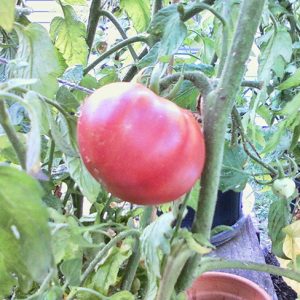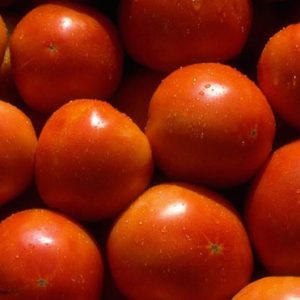calsfoundation@cals.org
Tomato Industry
The tomato industry has a long history in Arkansas and is particularly known in the northwestern and southeastern areas of the state.
Tomatoes appeared early in the state’s history. During the 1830s, Albert Pike, who owned the Arkansas Advocate newspaper, made the tomato the centerpiece of his campaign to expand food choices for the state. However, tomatoes were not grown on a large scale until commercial canning plants became common in the state. The town of Yocum (Carroll County), for example, had a plant operating in the 1880s, and in subsequent decades, canneries and tomato sheds were built across the state. Tomatoes grown in the Ozark Mountains were packaged in a variety of ways, from whole tomatoes to catsup. During the Great Depression, home demonstration clubs taught tomato canning, among other skills, to residents. However, tomato blight hit northwestern Arkansas in the 1940s, forcing farmers there to look elsewhere for their livelihood.
Probably the most well-known tomato-producing part of the state is Bradley County, famous for its “pink” tomatoes. Tomatoes are characterized as a pink breed when the skin is translucent and the ripe interior looks pink instead of red when the fruit matures to the breaker stage. Pink tomatoes were first sold commercially in the county in 1923, at a time when cotton was becoming less profitable for many farmers. The Jim Johnson family of Jersey (Bradley County), the Rufus Woodward family of Ingalls (Bradley County), and the Nathan Barber family of Warren (Bradley County) were among the first families to grow plots of tomatoes. With assistance from county agent C. S. Johnson, Woodward experimented with vegetable truck crops for marketing. Woodward discovered that he was able to grow tomatoes from seeds in a hot bed that were later transferred to a cold frame and remained covered for protection from a possible frost until they were placed in the fields. Over the next two decades, more farmers experimented with pink tomatoes in Bradley County.
Before 1949, farmers in Bradley County peddled tomatoes and other crops from their trucks. Often farmers had contracts with grocery stores, such as Kroger and Safeway, and drove to Pine Bluff (Jefferson County), Little Rock (Pulaski County), and Joplin, Missouri, among other locations. In 1949, farmers of the Hermitage (Bradley County) area came together and formed the privately owned Hermitage Tomato Market. The market was styled after a tobacco auction of that time. Buyers drove in each summer to bid on boxes of tomatoes. Buyers for the original Hermitage Market were from throughout Arkansas, out of state, and Canada. Hermitage proved an immediate success. In 1950, the pink tomato crop returned a gross over $2 million for the Bradley County farmers.
Warren formed its own market in 1953. There were about 100 farmers in Warren in 1954, most of whom had only one quarter of an acre or perhaps two acres of tomatoes. The market provided them additional income; farm loans were also available to assist these families. If they made their money back, they paid back their loan. The markets were prosperous at each of their beginnings, and Bradley County’s pink tomato landed in grocery stores throughout the nation. Community leaders also raised money to enlist assistance from the University of Arkansas Cooperative Extension Service (UACES).
In 1956, the Bradley County Pink Tomato Festival made its debut on a hot June day. It was a one-day event that gave members of Bradley County the opportunity to celebrate the crop and the workers who made it a success. Events were added almost every year, and many of the traditions are still maintained during this now week-long event each June.
The first known breed of commercially sold pink tomato was the Gulf State Market tomato, often simply referred to as the Gulf State. The breed grew in Bradley County for close to thirty years, well into the 1950s. However, the Gulf State was not resistant to Fusarium Wilt Race 1, a disease that can damage and kill plants. Joe McFerran and Jack Goode from the UACES experimented with different varieties. After the Gulf State tomato came a breed created by the U.S. Department of Agriculture (USDA), the Pink Shipper tomato. Then, in 1961, McFerran crossed the Gulf State with a USDA- numbered line with resistance to Fusarium Wilt, and he introduced the Bradley Pink tomato. It had resistance to Race 1, unlike the Gulf State. Eventually, though, Race 1 mutated into Race 2 and killed the Bradley. A decade later, the Traveler was another pink breed introduced by UACES as the result of a crack-resistance experiment. It was later followed by the Traveler 76.
A major shift in the tomato industry occurred in the mid-1980s, with red tomatoes gaining prominence in the commercial market over the more problematic pink tomatoes. Pink breeds, which are more prone to disease, have to be pruned more often than red breeds, usually every week to two weeks. Red breeds are also much firmer than pink, and this decreases the chance of shipping damages. Numbers drastically decreased statewide in tomato production during the 1980s when the switch was made from pink to red breeds throughout the nation, but some families who were active in the early pink tomato industry have younger generations maintaining the tradition of growing pink tomatoes. Red breeds remain the primary shipping tomato, but many Bradley County farmers still grow some form of pink tomato.
In fact, the production of heirloom tomatoes has been on the rise in Arkansas. An heirloom is any tomato variety that is at least fifty years old and is open pollinated. Many people appreciate the improved taste and variety to be found in these breeds. Heirloom seeds can also be saved and replanted each year, whereas hybrid breeds cannot use the same seeds year after year. Bob Stark and Paul Francis from the University of Arkansas at Monticello (UAM) are conducting research to examine how heirloom tomatoes can help the economic growth of southeastern Arkansas and are working with farmers and other supporters to promote heirloom breeds in Arkansas. Supporters hope that the name recognition of past popular pink breeds, such as the Arkansas Traveler, will play a significant role in reincorporating heirloom tomatoes into the Arkansas tomato industry.
For additional information:
“Best Crops Since ’50 Forecast for Tomato Farmers.” Eagle Democrat, June 16, 1955, p. 1.
Bradley County Pink Tomato Farming: The Early Years. CD-ROM. Warren, AR: Southeast Arkansas Community Based Education Center EAST Lab, 2009.
Bradley County Pink Tomato Festival. http://www.bradleypinktomato.com/ (accessed October 13, 2021).
Newton, Robert, and Patricia Newton. Bradley County Arkansas Family Histories. Warren, AR: The Eagle Democrat, 1993.
Norcross, Herrick F. Grade and Price Relationships for the Arkansas Tomato Industry at Local Auction. Fayetteville: University of Arkansas Cooperative Extension Service, 1989.
“Tomatoes.” Arkansas Home and Garden. http://www.arhomeandgarden.org/fruits_nuts_vegs/Vegetables/tomatoes.htm (accessed October 13, 2021).
Leah Forrest Sexton
Arkadelphia, Arkansas
 Agriculture
Agriculture Arkansas Times and Advocate
Arkansas Times and Advocate Official State Fruit and Vegetable
Official State Fruit and Vegetable Bradley Pink Tomato
Bradley Pink Tomato  South Arkansas Vine Ripe Pink Tomato, Official State Fruit and Vegetable
South Arkansas Vine Ripe Pink Tomato, Official State Fruit and Vegetable 




Comments
No comments on this entry yet.